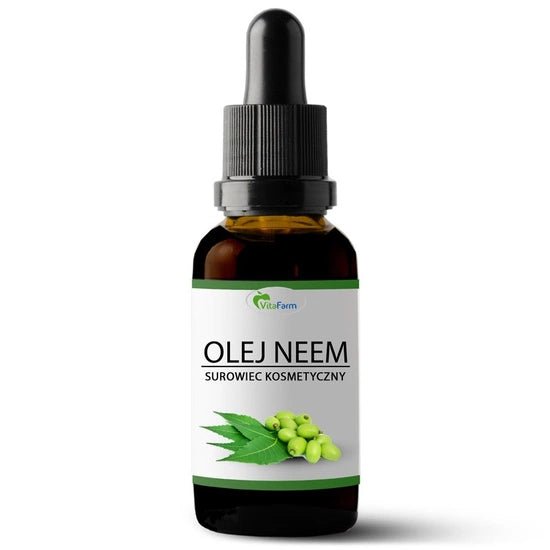Neem Oil for pest control 100% natural 100ml
Neem Oil for pest control 100% natural 100ml
Failed to load pickup availability
What is Neem oil?
Neem oil comes from the neem tree (Azadirachta indica), which is a native species found in South Asia, Southeast Asia, and parts of West Asia. Neem is considered a sacred tree in India and has many uses. Neem oil is produced from the seeds of the neem tree, thus possessing health and skincare properties. It is often used in Ayurvedic medicine to relieve internal inflammations, skin diseases, and hair problems. Neem oil is also commonly used in agriculture as a natural method against pests and diseases.
It is one of the strongest natural antifungal agents in the world with powerful antimicrobial and antibacterial effects. This oil is the number one remedy in the fight against various parasites and skin diseases. It is effective against 14 fungi that infect nails, skin on feet, digestive tract, hair and scalp, bronchi, lungs, and genitals. The oil is truly a miracle remedy. However, considering its huge amount of active substances and strong, specific smell - the oil must be diluted before use. The unpleasant smell of neem is not a problem because it practically disappears as soon as the oil dries.
Our Neem Oil Quality
Our offered Neem oil is 100% natural, unrefined, and cold-pressed. This means it is mechanically extracted without using high temperatures or chemical solvents. This process preserves all the valuable active substances of the oil, ensuring its effectiveness.
What is its consistency? At cold temperatures (below ~20°C), the oil naturally thickens and can become solid, similar to a paste. In warmth, it quickly returns to a liquid form. This is a normal and desirable property that confirms the product's naturalness.
What is Neem oil used for?
Home Plant Protection: Effective against various plant pests (e.g., aphids, spider mites, armored scales, etc.).
Insect repellent: natural household insect repellent.
Anti-mold: Effective against various types of fungi.
Garden Pest Control: acts against many pests such as aphids, spider mites, armored scales, root-feeding insects, etc. It can be used as a spray both to kill and repel pests.
Disease prevention: acts against plant fungi and diseases. It can be used to prevent or treat disease symptoms.
Fertilizer: contains nutrients beneficial to plants. It can be used to improve yield and plant quality, but careful use is recommended to avoid plant damage.
For skin, hair, and nail care: Neem oil contains many fatty acids, vitamin E, and amino acids; it helps restore skin moisture balance, elasticity, disinfects, and regenerates.
Neem oil has very strong antibacterial properties, so it is recommended for problematic skin with increased sebaceous gland secretion, pustular acne, and enlarged pores. This oil heals acne, eczema, and moisturizes especially dry skin.
Neem oil helps to prevent redness, itching, and improves skin condition. It is also recommended for eczema.
For skin use: it is recommended to apply pure neem oil in a very thin layer on damp skin or mix it with other oils and butters. Neem oil becomes more liquid when slightly warmed.
Hair improvement: Moisturizes and nourishes hair, prevents dandruff, and reduces hair loss.
Immune system support: Polyphenol compounds help improve immunity, offering antiviral and antibacterial effects.
Anti-aging effect: Natural antioxidants fight free radicals, preventing premature aging.
How to use neem oil on plants?
Neem oil is a plant lover's "first helper" because it is an effective 3-in-1 solution:
-
Insecticide: Helps control common indoor plant pests (aphids, spider mites, thrips, scale insects, mealybugs, etc.).
-
Fungicide: Helps fight various fungal diseases, such as powdery mildew.
-
Acaricide: Especially effective against mites, such as spider mites.
How Does Neem Oil Work?
Unlike chemical insecticides, which act as immediate poison, Neem oil works smarter and gentler:
-
Stops feeding: By coating the plant, it makes the leaves unpalatable, and pests stop eating them.
-
Disrupts reproduction: Its active substances affect the pest hormone system, disturbing their growth and ability to reproduce.
-
Mechanically acts: The oil mixture can clog the respiratory tracts of smaller pests (e.g., spider mites).
The result is not immediate, but it is long-term and effective, interrupting the pest life cycle.
How to Properly Prepare and Use Neem Oil for Plants?
This is the most important step! Neem oil must not be used in pure form and cannot simply be mixed with water, as oil does not dissolve in water. To create an effective spray mixture, liquid soap is necessary.
Basic recipe (approximately 500-750 ml of mixture):
-
1 teaspoon (about 5ml) of liquid soap.
-
1-2 teaspoons (about 5-10ml) of Neem oil.
-
500-750 ml warm (not hot) water.
Preparation Steps:
-
In a small container, first thoroughly mix the Neem oil with the soap. The mixture should become homogeneous and milky.
-
Pour this emulsion into a spray bottle filled with 500-750ml of warm water.
-
Shake the bottle well to ensure everything is evenly mixed.
-
The mixture must be used immediately (within a few hours), as it loses its effectiveness and separates.
How to Use the Mixture:
-
For pest control: 1-2 times a week. Treatment should be carried out for at least 2-3 consecutive months to affect all pest development cycles.
-
For prevention: 1-2 times a month.
Spray the entire plant – leaves on both sides (especially the underside!), leaf axils, and stem. The remaining mixture can be poured into the soil to affect pest larvae.
! Important to Observe:
-
Spray in the evening: Do not treat plants in direct sunlight. Oil in the sun can act like a lens and cause leaf burns.
-
Perform a test: Before treating the entire plant, always test the mixture on one or two leaves and wait 24 hours to ensure the plant is not overly sensitive.
Other Uses
Insect repellent at home: mix about 10 drops of neem oil with 1/2 teaspoon of soap and mix with 1 liter of water. Use for spraying windows, doors, or floors.
Against fungi: mix about 10 drops of neem oil with 1/2 teaspoon of soap and mix with 1 liter of water. Spray walls, furniture, or carpets.
Plant disease prevention: Use about 5 drops of oil with a few drops of dish soap and mix with 500ml water. Use once or twice a week depending on the level of infection.
Fertilizer: The recommended dose is 1-2 teaspoons per liter of water.
Skin care: apply a small amount of oil to the skin and gently massage.
Hair care: add a few drops to conditioner or shampoo.
Additional Information
Ingredients: 100% Neem seed oil (Melia azadirachta seed oil) Storage: Store the oil in a tightly sealed container at room temperature, in a dry and dark place. Keep away from direct sunlight, moisture, and children.
🌡️ COLD TIME! If the outside temperature is below +5°C, be sure to add a heat pack to the order so that plants and predatory mites do not freeze on the way.
⚠️ Important about the heating element! ‼️ 1 heating element per 1 order – it is not necessary to put one for each plant. ‼️ Provides heat for up to 72 hours. Without a heating element – we do not take responsibility for frozen plants and predatory mites.
📦 Pick up on time! When the package is delivered, pick it up the same day. Do not leave the package in the parcel locker overnight! Cold can damage plants and predatory mites.
Delivery costs
🇱🇻 Latvia Omniva/Smartpost €4.50 Courier €8 Free delivery for orders over €50
🇪🇪&🇱🇹 Estonia and Lithuania Omniva/ Smartpost parcel locker 5€. Courier 8€. Free delivery from 50€
🇫🇮 Finland Delivery to parcel locker €10.90 Delivery to home €12.90
🇸🇪 Sweden and 🇩🇪 Germany Delivery to home 18€
The stock of goods in the warehouse and in our online store may differ, so if we are unable to fulfill your order or can only fulfill part of it, we will refund you for the unavailable goods. The refund period is 10 working days. Product photos are for informational purposes and their color may vary slightly depending on the monitor screen brightness as well as the lighting of the photograph. The pictures show examples of plants you will receive, but please note that each plant is unique and may differ from what is shown in the pictures.
View full information



